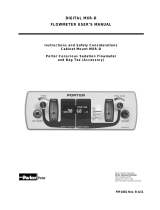
4 Amico Corporation
User Responsibility
Introduction
The information contained in this Installation, Operation and Maintenance Manual pertains only to the Alert-3
microprocessor based digital LCD Alarm. This product will perform as described in this manual when assembled,
operated, maintained and serviced in accordance with the installation instructions provided.
The alarm must be checked periodically. Parts that are broken, missing, worn, distorted or contaminated must be
replaced immediately. Should such repair or replacement become necessary, please contact Amico Corporation or their
distributors.
Alarms should not be altered without prior written or verbal approval from Amico Corporation or a factory trained
service technician. Failure to comply will void all warranty on the alarm.
Statements in this manual preceded by the words WARNING, CAUTION, DANGER and NOTE are of special signicance.
Please read these sections carefully.
NOTE: Amico strongly recommends that alarms be checked annually by qualied sta.
The Amico Medical Gas LCD Alarm System (Alert-3) incorporates the latest microprocessor based technology for alarm
and surveillance systems. The alarm has been designed to provide user exibility and reliability. This manual shall enable
the customer to install, use and maintain the alarm appropriately.
There is one “MUTE” ( ) or “PUSH TO TEST” button located on the front face of the LCD alarm. The button has two
functions: to silence an alarm that has occurred and to view the audible alarm sound level at high and low set points.
When an audible alarm is triggered, press the button to silence the alarm. To view the audible alarm sound level at high
and low set points, press and hold the button for 20 seconds to display the information on the LCD Alarm screen.
All Gases or Vacuums are displayed on the LCD alarm for clear visibility to facilitate the monitoring function by hospital
personnel. Under normal operation, the gas indicator will be in the “GREEN - OK” position. If an alarm condition occurs, a
“RED-Alarm” indicator will be displayed and an audible alarm shall be continuous until silenced by pushing the “MUTE”
button.
The LCD Alarm can be connected to a “Building Management System” for a generic alarm dry contact fault indicator.
WARNING: denotes steps which can prevent injury.
CAUTION: denotes steps which can prevent damage to equipment.
DANGER: denotes steps which can prevent electrical shock to equipment
or to prevent serious injury and/or death.
Amico Microprocessor Based Alarm
Page: 4
USER RESPONSIBILITY
The information contained in this Installation and Operation Maintenance
Manual, pertains only to the ALERT-2 microprocessor based digital alarm.
This product will perform to conformity with the descriptions contained in this
manual, when assembled, operated, maintained and serviced in accordance
with the installation instructions provided.
The alarm must be checked periodically. Parts that are broken, missing,
worn, distorted or contaminated, must be replaced immediately. Should such
repair or replacement become necessary, please contact Amico Corporation
or their distributors.
All alarms should not be repaired, or altered without prior written or verbal
approval of Amico Corporation or it’s distributors. Failure to comply will void
all warranty on the alarm.
Statements in this manual preceded by the words
WARNING, CAUTION,
DANGER and
NOTE are of special significance. Please read these sections
carefully.
WARNING: denotes steps which can prevent injury.
CAUTION: denotes steps which can prevent damage to equipment.
DANGER: denotes steps which can prevent electrical shock to equipment
or to prevent serious injury and/or death.
Amico Microprocessor Based Alarm
Page: 4
USER RESPONSIBILITY
The information contained in this Installation and Operation Maintenance
Manual, pertains only to the ALERT-2 microprocessor based digital alarm.
This product will perform to conformity with the descriptions contained in this
manual, when assembled, operated, maintained and serviced in accordance
with the installation instructions provided.
The alarm must be checked periodically. Parts that are broken, missing,
worn, distorted or contaminated, must be replaced immediately. Should such
repair or replacement become necessary, please contact Amico Corporation
or their distributors.
All alarms should not be repaired, or altered without prior written or verbal
approval of Amico Corporation or it’s distributors. Failure to comply will void
all warranty on the alarm.
Statements in this manual preceded by the words
WARNING, CAUTION,
DANGER and
NOTE are of special significance. Please read these sections
carefully.
WARNING: denotes steps which can prevent injury.
CAUTION: denotes steps which can prevent damage to equipment.
DANGER: denotes steps which can prevent electrical shock to equipment
or to prevent serious injury and/or death.
Amico Microprocessor Based Alarm
Page: 4
USER RESPONSIBILITY
The information contained in this Installation and Operation Maintenance
Manual, pertains only to the ALERT-2 microprocessor based digital alarm.
This product will perform to conformity with the descriptions contained in this
manual, when assembled, operated, maintained and serviced in accordance
with the installation instructions provided.
The alarm must be checked periodically. Parts that are broken, missing,
worn, distorted or contaminated, must be replaced immediately. Should such
repair or replacement become necessary, please contact Amico Corporation
or their distributors.
All alarms should not be repaired, or altered without prior written or verbal
approval of Amico Corporation or it’s distributors. Failure to comply will void
all warranty on the alarm.
Statements in this manual preceded by the words
WARNING, CAUTION,
DANGER and
NOTE are of special significance. Please read these sections
carefully.
WARNING: denotes steps which can prevent injury.
CAUTION: denotes steps which can prevent damage to equipment.
DANGER: denotes steps which can prevent electrical shock to equipment
or to prevent serious injury and/or death.



























